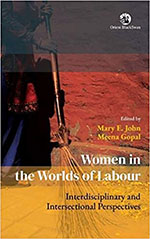The question of women’s labour has been central to most women’s studies classrooms across the world.The book edited by Mary EJohn and Meena Gopal is pathbreaking because it takes the question of women’s labour out of the confines of traditional women’s studies by adopting an interdisciplinary and intersectional perspective. The book opens with a section that is almost akin to a masterclass on the issues of women and labour in India in specific, accompanied by a very exhaustive discussion of the shifting theoretical paradigms, scholarly debates and literature review. This section has essays by Mary E John, Samita Sen, Rajni Palriwala and Neetha N—all scholars whose names are associated with landmark and iconic research and writing on women and labour.
The introduction begins with reminding the readers about some landmark struggles in recent times led by women—the Dalit women-led tea plantation workers’ struggle in Munnar, Kerala, the very big anganwadi women workers’ struggle in Delhi and so on. These movements and many like these in India and elsewhere in the world, led largely by women, draw our attention to the precarity that has come to characterize women worker’s lives. And yet, as Meena Gopal and Mary E John write, women have risen to the occasion, mobilized, resisted and won in many instances. The editors believe that these struggles are powerful signals urging civil society, government and policy makers, hostile media, other social movements including the women’s movements and a largely disinterested public that women must be fully recognized for the workers that they are—and not as accidental or incidental part of the workforce. The introduction ends by earmarking the need for an epistemological and ideological shift to understand the shifting contours of women’s labour and the various forms of resistance they are mounting along the intersections of caste, region, class, sexuality and other social relations.

